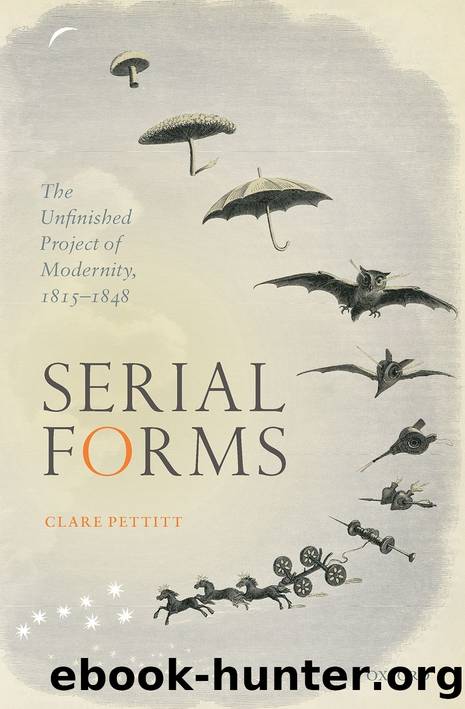Serial Forms: The Unfinished Project of Modernity, 1815-1848 by Pettitt Clare;

Author:Pettitt, Clare; [Pettitt, Clare]
Language: eng
Format: epub
ISBN: 9780198830429
Publisher: OxfordUP
Published: 2020-05-12T00:00:00+00:00
Serial Forms: The Unfinished Project of Modernity, 1815â1848. C. J. Pettitt, Oxford University Press (2020). © Clare Pettitt.
DOI: 10.1093/oso/9780198830429.001.0001
1 Ernst Bloch, Tübinger Einleitung in die Philosophie (Frankfurt am Main: Suhrkamp, 1970), S.129. Translation my own. John Cumming translates this as âTime is only because something happens, and where something happens, there time isâ: Ernst Bloch, A Philosophy of the Future, trans. John Cumming (New York: Herder & Herder, 1970), p. 124.
2 Nicholas Daly has noticed that â[a]s a narrative device, theatrical special effect, and sublime fine-art spectacle, inter alia, ⦠[the volcanic disaster narrative] crosses not just genres and modes, but mediaâ: Nicholas Daly, âThe Volcanic Disaster Narrative: From Pleasure Garden to Canvas, Page, and Stageâ, Victorian Studies 53:2 (Winter 2011): 255â85, p. 256.
3 [Anon.], âPompeiiâ, Blackwoodâs Edinburgh Magazine (April 1824): 472â5, pp. 472â3. See also Altick, Shows of London, p. 181. This refers to Robert Burfordâs panorama âThe Ruins of Pompeii and the Surrounding Countryâ which opened in November 1823 on the Strand. A view of âThe City of Naplesâ including Mount Vesuvius had been exhibited in 1821 [The Morning Chronicle (Saturday 10 February 1821), advertisement, front page].
4 For de Loutherbourg, see Altick, Shows of London, pp. 96, 117â27.
5 Thomas McDonald Rendle, Swings and Roundabouts: A Yokel in London (Chapman & Hall 1919), p. 140. Martinâs canvas was itself based on Edwin Atherstoneâs long poem The Last Days of Herculaneum (1821). A review of the Egyptian Hall Martin show appeared in âFine Artsâ, Literary Gazette 270 (23 March 1822), p. 185.
6 R.H., âPicture of the Destruction of Pompeii and Herculaneumâ, Examiner (7 April 1822), p. 219. The canvas was displayed alongside a display of live reindeer and Laplanders posing in front of a diorama. See Martin Myrone (ed.), John Martin: Apocalypse (London: Tate Publishing, 2011), pp. 109â10. In May 1828, crowds flocked to the Western Exchange, Old Bond Street, to see John Martinâs The Deluge (1826) and The Destruction of Nineveh (1828).
7 Lord Byron, The Age of Bronze, or Carmen Seculare et Annus Haud Mirabilis (London: John Hunt, 1823), p. 12 ll. 181â2. Byron himself had refused to travel to Naples to view Vesuvius. âCertainly he did not travel for fashionâs sake, nor would he follow in the wake of the herd of voyagers. As much as he had heard about the Mediterranean, he had never visited Vesuvius or Aetna, because all the world hadâ: R. N., âPersonal Character of Lord Byronâ, London Magazine 10 (October 1824): 337â47, p. 346. According to some, Byronâs dismissal of Vesuvius was in a âtone of dandyism he was wont to adoptâ: H. W. B., âLetters from the Journal of a Travellerâ, Metropolitan Magazine 78 (October 1837), p. 221.
8 [George Mogridge], âEruption of Mount Vesuviusâ, in Sergeant Bell, and his Raree-Show, pp. 76â82. Thanks are due to Kate Flint for drawing my attention to this. Charles Dickens, âHis Brown-Paper Parcelâ, in Charles Dickens, Somebodyâs Luggage, ed. Melissa Valiska Gregory and Melisa Klimaszewski (London: Hesperus Press, 2006), pp. 81â91, p. 87.
9 [Anon.], âTheatrical Examiner: Kingâs Theatreâ, Examiner 1207 (20 March 1831), p.
Download
This site does not store any files on its server. We only index and link to content provided by other sites. Please contact the content providers to delete copyright contents if any and email us, we'll remove relevant links or contents immediately.
The Power of Myth by Joseph Campbell & Bill Moyers(925)
Half Moon Bay by Jonathan Kellerman & Jesse Kellerman(908)
A Social History of the Media by Peter Burke & Peter Burke(879)
Inseparable by Emma Donoghue(844)
The Nets of Modernism: Henry James, Virginia Woolf, James Joyce, and Sigmund Freud by Maud Ellmann(737)
The Spike by Mark Humphries;(719)
The Complete Correspondence 1928-1940 by Theodor W. Adorno & Walter Benjamin(703)
A Theory of Narrative Drawing by Simon Grennan(703)
Ideology by Eagleton Terry;(655)
Bodies from the Library 3 by Tony Medawar(647)
World Philology by(645)
Culture by Terry Eagleton(641)
Farnsworth's Classical English Rhetoric by Ward Farnsworth(640)
A Reader’s Companion to J. D. Salinger’s The Catcher in the Rye by Peter Beidler(611)
Adam Smith by Jonathan Conlin(605)
Game of Thrones and Philosophy by William Irwin(592)
High Albania by M. Edith Durham(589)
Comic Genius: Portraits of Funny People by(581)
Monkey King by Wu Cheng'en(575)
